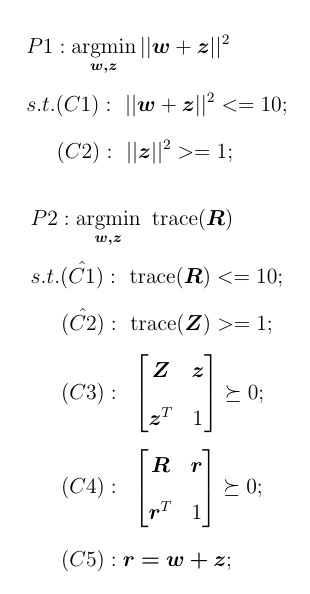The original problem is given as P1. Defining r=w+z, R=rr^H, Z=zz^H; the problem is transferred into P2, where new constraints are relaxed from R=rr^H, Z=zz^H.
But I am confused in how to handle the constraint r=w+z in (C5). Because w and z are both complex vector, CVX always warns this.
Can someone kindly offer me any hint? You valuable comments are highly appreciated!
Unless w and z are real, or w+z is constrained to be real (i.e.imag(w+z) ==0), then the constraint trace(R) <= 10 and the objective minimize trace(R) don’t make sense, although they could be modified to be in terms of real(R) .
So you need to be clearer on what problem you are trying to solve. It appears that you extracted these formulations from another source. So perhaps you need to study that source more carefully.
Hi Mark, thanks for your kind reply. 
Indeed, w and z are complex value vectors in the problem. As I define R=rr^H and Z=zz^H, so I think the trace® and trace (Z) might be real number and they can go through CVX. However, constraint (C5) returns warning as a complex value cannot be compared with a real value. Should I also process (C5) in terms of matrix?
You can not enter R=rr^H and Z=zz^H into CVX, as they are non-convex. P2 has semidefinite relaxations of those.
I don’t really know what you’re doing.,so I don’t know what makes sense. As I wrote in my previous reply, you could use real and imag to force things to be accepted by CVX, but I don’t know whether that is solving the correct problem. That is why I suggested you need to study the source (paper, course notes, book, homework assignment, or whatever) of these formulations
Hi Mark, many thanks. As you suggested, I will double check my problem  .
.
Thanks for your comments.





